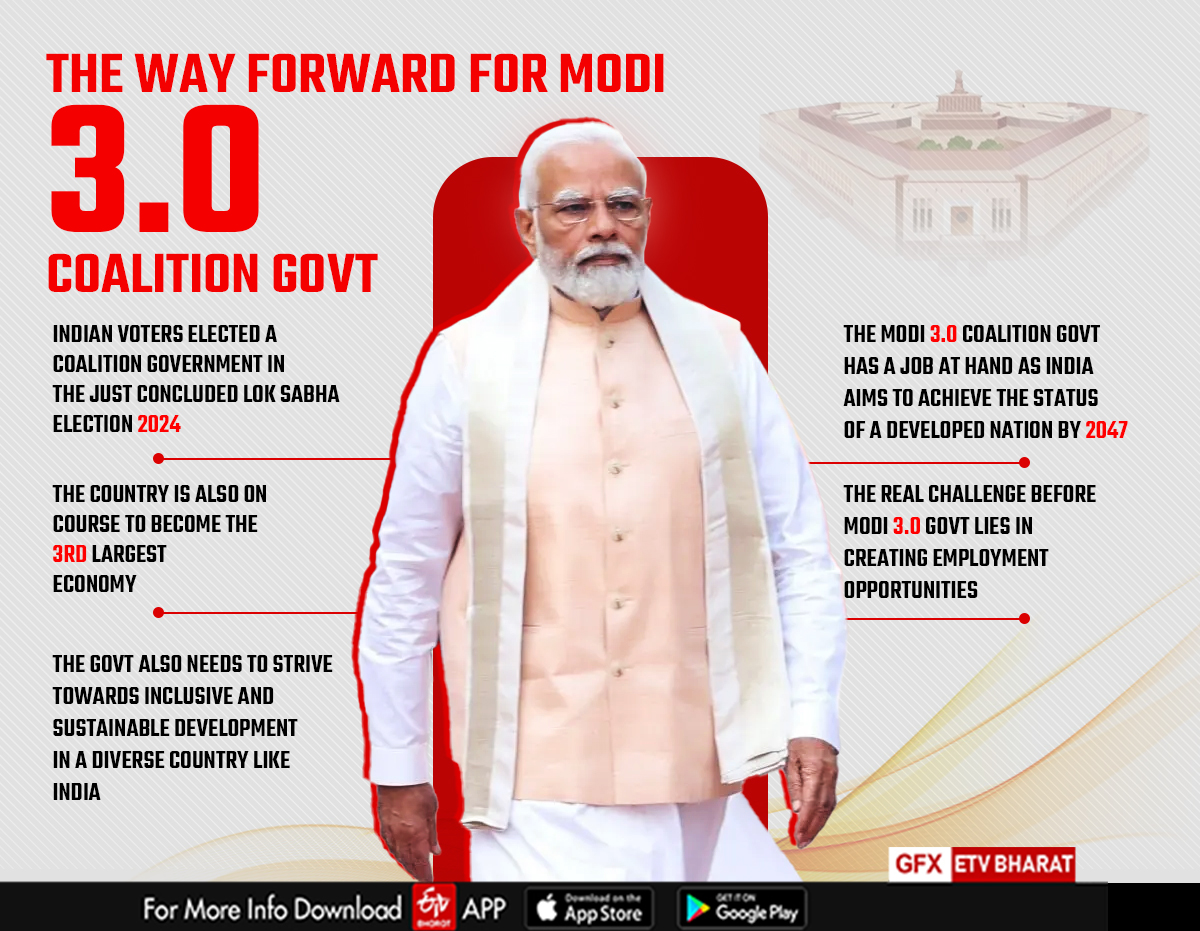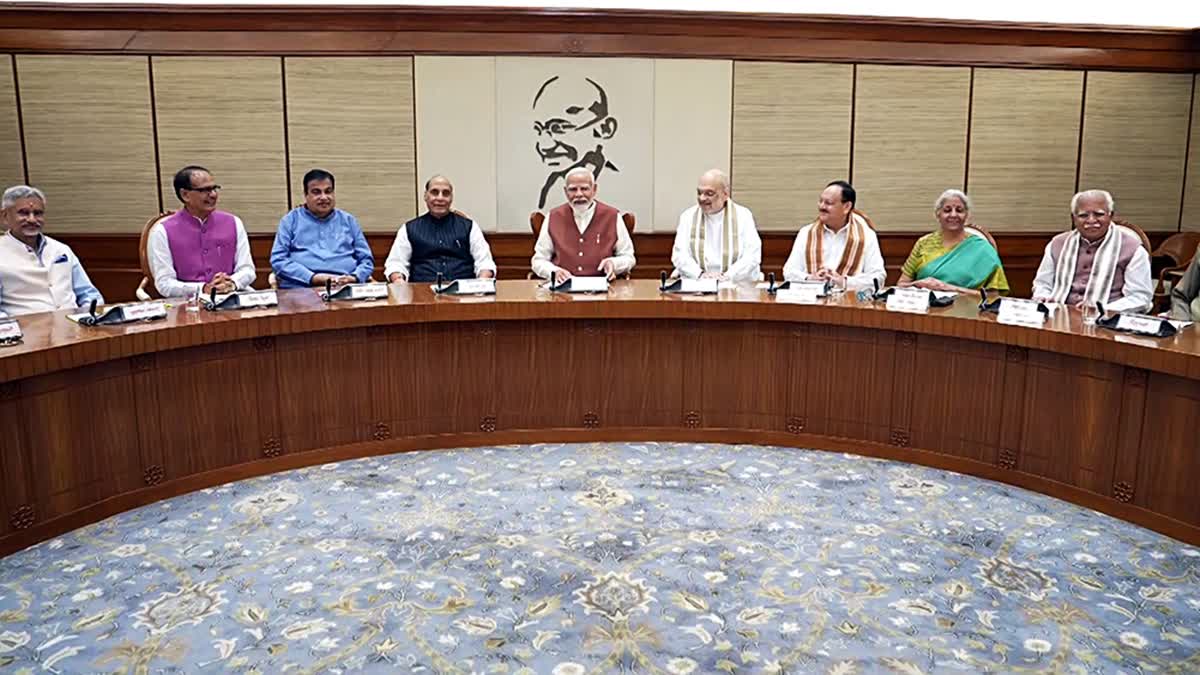The recent Lok Sabha election 2024 showcased our vibrant democracy. The biggest achievement since independence is the continuation of democracy. The Indian voter has given the verdict and it would be a coalition government at the Centre. The Oath ceremony of Prime Minister and other Ministers is over and the new government will start working now. India is now aspiring to achieve the status of a developed nation by 2047. The new government should focus not only on achieving higher GDP growth but also creating employment as people have revealed in the recent elections that employment is a critical issue. The policies should also focus on inclusive and sustainable development. There are opportunities and challenges for achieving higher growth, inclusion and sustainability for the new coalition government.
Two drivers of growth are investment and exports. Former RBI Governor, C Rangarajan, estimates the required growth rates for India to achieve the goal of developed nation by 2047. The current criterion to achieve developed country status is to reach per capita income level of US $ 13,205. Assuming the cut-off will increase to $15000 and with depreciation of rupee, the required real growth rate is 7% per annum. To achieve this gross fixed capital formation has to rise from the current level of 28% of GDP to 34% of GDP. Apart from public investment, private investment has to be increased. Revival of private investment is a challenge as it has not taken off despite corporate tax cut, reforms like Insolvency Bankruptcy Code (IBC), GST, production linked scheme and increase in government capital expenditure. There is an urgent need to raise private investment in different sectors of the economy.

It is well known that exports are one of the main engines of growth and employment creation. India’s high GDP growth rate is generally accompanied by high export growth. But, now the global shocks will have some negative impact on India’s trade volumes. India can emerge as a major hub for final assembly-related activities within global value chains. However, one problem is that in recent years India’s trade policy has become more protectionist. India’s import tariff rates increased in recent years. It has to reduce tariffs to occupy the space vacated by China. In the name of Atmanirbhar, we should not be protective. No emerging market of India’s size has grown at 7 or 8 per cent for a decade or more without strong export growth.
India is now the fifth-largest economy and would become 3rd largest economy soon. However, in per capita terms India's rank is still 138 among 180 countries. China and India had same rank of per capita in 1990. But now China’s rank is 71 (with $12000) and India’s rank is 138 with $2600. Therefore, India has to go much faster now in order to catch up with other countries in per capita income.
One of the structural problems of Indian economy is lack of structural change from agriculture to manufacturing and services particularly in employment. Agricultural sector needs support on infrastructure and investment. The narrative of Indian agriculture has to be changed towards more diversified high-value production, better remunerative prices and farm incomes. Similarly, manufacturing share in both GDP and employment has to be improved for higher GDP growth and better jobs.
On inclusive growth, employment creation in quantity and quality are the biggest challenges for the new government. Between 2012 and 2019 economy grew 6.7% but jobs growth was just 0.1%. Employment is dominated by poor quality jobs in the informal sector. One also finds rise in informal employment within formal sector itself. The work participation rates of women are low in India compared to other countries. The problem of gig workers is another issue.
India has the largest youth population (15-29 years) around 27%. Demographic advantage differ across regions/states. Only eastern, northern and central regions have this advantage. The unemployment among youth is generally three times higher than total unemployment. 83 per cent of unemployed are youth. Unemployed rate among educated(secondary and above) youth is 18.4%, graduates 29.1% (female 34.5%). The unemployment is concentrated among youth and educated. The demand for reservations among different castes is due to high youth unemployment.
A Niti Ayog document mentions that in India only 2.3% of workers have formal skill training compared to UK 68%, Germany 75%, Japan 80%, South Korea 96%. Employability is a problem. 55% of the workers employability (right jobs) is a problem. On the other hand, a large proportion of highly educated young men and women including technically educated are overqualified for the jobs they are holding. One more issue is technology and employment. In developed countries, already there is decline in demand for labour due to AI and robots. India has to be prepared for this.
Another issue for inclusive growth is health and education. Dichotomy in health and education has to be fixed. There are islands of excellence like IITs and IIMs that can compete internationally in education while vast majority of educational institutions churn masses of children with poor learning achievement. A former education secretary said that “except getting most of the children to school, everything that could go wrong has gone wrong with school education in India”. The crisis extends to skills and makes India’s hopes for a demographic dividend seem largely misplaced. We need to move towards universal health care and spend 2.5 to 3 per cent of GDP on health. Equity in quality education and health is the key for raising human development and reduction in inequalities. Persisting inequalities across regions, castes, rural-urban, gender is another that has to be tackled by the new government.
Welfare programmes are important for inclusive growth. But, simultaneously we have to improve revenues and focus on development activities. Welfare programmes alone will not reduce poverty and inequality. Recent elections showed that the youth want employment and not just freebies. Chinese proverb on fishing sums up the welfare vs. development issue. If you give a man or woman a fish, you will feed him for a day. The next day the person will be hungry, you will have to feed another fish. If you teach how to fish, he will be able to provide himself a daily meal life long.
Former RBI Governor Subbarao said that our budgets are deficit which means the freebies are being financed by borrowings. If they do not contribute to growth and revenue the burden of repayment will fall on our children.
Apart from certain welfare programmes, focus on infrastructure by the government is important, as it is a key driver for higher growth and employment creation. Golden Quadrilateral highway road project connecting Delhi, Mumbai, Chennai and Kolkata started during PM Atal Bihari Vajpayee government. One study examined the impact of this project on manufacturing activity. It resulted in 49% overall output increase from initial levels for the average district. For instance moderate density districts like Surat in Gujarat or Srikakulam in Andhra Pradesh registered a more than 100% increase in new output and new establishment counts after the Golden Quadrilateral.
Similarly, sustainability and climate change are becoming important. The governments at central state and local levels have to be prepared to tackle climate change related issues. Urbanisation will increase in India over time. Inclusive and sustainable urbanization is important. Recently, Oxford Analytics brought out Global Cities Index. It shows that low human capital, poor quality of life, and environmental issues pull down the ranks of Indian cities. The development of Amaravati city in Andhra Pradesh by the new state government should keep in mind economic growth, human capital, quality of life, environment and governance to raise the quality of the city. Planned green cities are needed.
India is excessively centralised, politically and fiscally, a legacy of the fears of national disintegration uppermost in the minds of the drafters of the Constitution at Independence. The new coalition government should improve cooperative federalism as the action is more at state level. If India wants to be a developed country, the role of states is important.
Similarly, decentralization towards Panchayats and urban local councils is also important. Recent RBI study indicates how panchayats earn only 1% of their income through taxes, with the rest being sourced from Centre and State grants. Greater autonomy of panchayats results in better governance and superior outcomes in agriculture, rural development , health and education. A study shows that spending at the discretion of local governments where most services get delivered are 51 per cent in China, 27 per cent in the US and Brazil, and a distant 3 per cent in India.
To conclude, the new government has many opportunities and challenges in order to move towards the goal of developed nation by 2047. The recent elections also brought out the critical issues of employment particularly for youth. States should be given more importance in achieving this goal of growth, employment creation, inclusion and sustainability. There is no evidence that coalition governments are less efficient in achieving developmental goals as compared to the non-coalition governments.
(The author is former Chairman, the Commission for Agriculture Costs and Prices, GOI and Former Vice Chancellor, IGIDR, Mumbai. Views expressed are personal)



